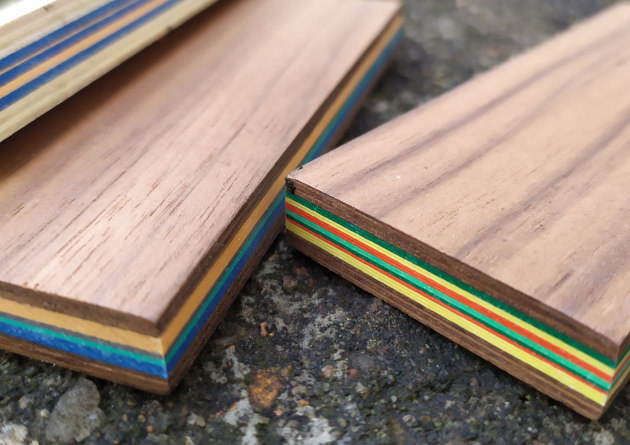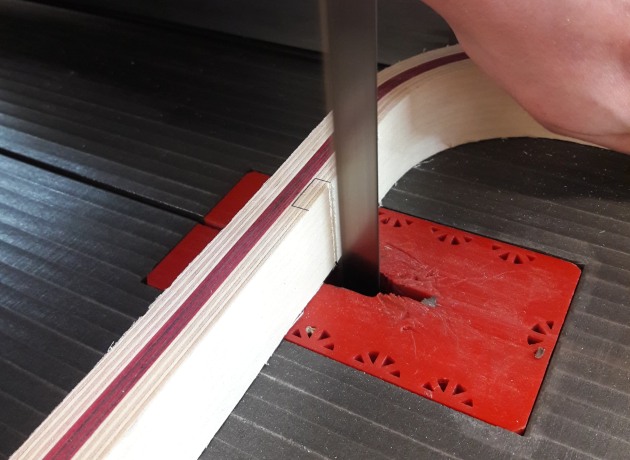Paper and wood
The award-winning Soil and Sea boxes by Louen Pinpin combined contrasting materials, and his and Laura Inguaggiato’s technical innovations.
Words: Louen Pinpin and Laura Inguaggiato
Photos: Laura Inguaggiato
Materials, ideas, relationships – when things go together well, good things can happen. Louen Pinpin was last year’s Bowls & Boxes category winner for Maker of the Year Awards. His unique Soil and Sea box design incorporated a flexible lid solution that incorporated veneer, paper and leather. The idea and technique for making it was a product of his skills combined with his own innovation and that of Laura Inguaggiato.
Recently settled in Australia, Louen and Laura met eight years ago at École Boulle, France’s renowned school for art and design, where furniture and cabinetmaking with their associated decorative arts are taught.
Detail of the blackwood, paper and leather hinged lid on Soil and Sea box
Laura went into the course after secondary school and built on her interests in art and literature to expand her skills into furniture design. After her formal furniture studies, Laura specialised in straw marquetry, a 17th century furniture decoration technique which relies on fine detail and achieving a balance between colour and pattern. Laura is one of a select few who have mastered this technique in Australia, and now works with noted straw marquetry master Arthur Seigneur in Melbourne.
Louen joined the furniture-making world after his junior secondary certificate before also spending six years in formal study of furniture making and design. His main focuses were techniques, problem solving, material combination and boat building techniques. Louen was drawn to working on wooden boats as both the shapes and technical challenges attracted him. He now works at the Victorian Wooden Boat Centre.
Laura Inguaggiato’s final design and make projects at École Boulle included a limited production writing desk with colour options.
Colour and connection
At École Boulle, students may work towards a series of diplomas. During the final year of cabinetmaking studies, students make furniture of their own design. Laura’s interest lay in designing a cabinet for limited production which could also be customised
Her research into colour theory via the writings of Michel Pastoureau1, Paul Simpson2, and others, supported the notion that colour is important in how we connect to objects, and its appreciation is influenced by history, culture, and personality. Offering clients colour options could therefore be a way to satisfy individual tastes and interiors.
Commercially available coloured panels and boards were considered before Laura began experimenting with shopmade coloured plywood, dyed veneers and tinted cardboard. She found the ‘chemicals, mess and wastage’ involved did not justify the outcome. Finally, using coloured paper became an obvious choice.
Layers of coloured drawing paper and veneer are glued into a panel which offers design potential for furniture.
Paper in furniture making
Paper has been used as a decorative and structural furniture element throughout history. It has often been used as an embellishment, and commonly as a lining for some drawers, trunks and wardrobes. For centuries it has also been an economical alternative to wood in the furniture industry. In France, from the 16th century onwards, objects and later furniture were made from papier mâché, or in other words, boiled cardboard. This material facilitated the creation of furniture with refined curves, and was often decorated with black and gold lacquer, painted motifs and mother-of-pearl marquetry. The delicacy and the range of furniture made in this way was extensive.
Cutting joinery on a curved paper and veneer lamination
Paper panels
Formica, a high pressure laminate, is an early example of paper used on an industrial scale to incorporate colour and pattern. A more recent example of a paper and wood plywood is the ‘paper wood’ developed by Drill Design and Full Swing in 2007, and used by Takizawa Veneer in Japan. More recently, the Swedish designer Sophie Hardy created a paper plywood for her ‘Breaking the surface’ tabletops where 64 layers of paper and veneer are CNC-carved to reveal colourful patterned edges.
Paper types
In combining paper and veneer to create panels and bent plywood it is necessary to consider the highly variable nature of paper. Almost every type of paper is cellulose based, but pulp recipes vary and this can affect quality and porosity. The manufacturing process and the addition of different chemicals during paper fabrication can cause variations in bonding between plywood layers. Drawing paper was used for the Soil and Sea boxes because it is economical and available in a range of colours.

View of the Soil and Sea boxes just off the panel saw before gluing
Coated and uncoated papers
Acid free paper lasts longer, however it is a coated paper. Chemical coatings lower the ink absorption but result in a homogeneous, smooth and brighter papers.
The main problem that Laura has encountered during gluing tests has been delamination. Layers of paper bond easily, however when torsion is applied separation can occur. Glue absorption can be improved by perforating the paper first with a needle. Sanding the sheets of paper was considered, however this has proved time-consuming and affected flatness.
The size of the paper sheets is another factor to consider. The most common commercial size of coloured paper sheets (in Europe) is 500 x 650mm. To create larger panels, it is possible to join the sheets with veneer tape, but care must be taken with the placement of the tape to avoid uneven thicknesses.
The size of the board created is also determined by the equipment available. Even and consistent pressure can be produced on a hydraulic press, however these are not common to many workshops in Australia, Laura explained. The bending ply for the cabinet she produced was created through the use of moulds. Creating custom-sized panels also works towards reducing waste.
Adhesives
Epoxy glue has proved to be the best for this application and adds strength to the material. PVA glue can also work, however epoxy gives a ‘harder’ result, and the drying time with PVA is longer as the paper tends to absorb the water contained in the glue.
Balancing the materials
The final consideration is balancing the ratio of paper to wood. The veneer is the strongest element and sufficient wood is needed to permit effective machining. Laura and Louen are currently using commercial 0.06mm veneers in combination with drawing paper and epoxy glue.

The leather backing built on the use of leather hinges in furniture that Louen Pinpin experimented with as a student at École Boulle.
Possibilities and future use
Last year’s Maker of the Year Awards were an opportunity to collaborate further technical and aesthetic experimentations. Louen’s Soil and Sea boxes were the second successful use of this shopmade material, after Laura’s customisable production cabinet.
The boxes utilised the flexible leather hinge technique which Louen developed in his final diploma project at École Boulle.
Now the partnership plans to keep exploring the technical capacity and limits of this material, its durability and mechanical resistance. Testing different papers and glues is also part of the plan with the goal of creating a sustainable material in mind.
‘The technique is one that we’re experimenting with and developing, explains Louen. ‘It’s not a sure science. We haven’t tested all papers and adhesives, and lots of attempts haven’t worked – you need to do a lot of tests – you’re never sure if different papers or glues will work’.
‘We would like to bring a new way of working with colour to the furniture making industry’, said Laura. ‘The incorporation of colour and pattern can create a bond between the user and the piece of furniture, while offering strong and graphic design possibilities.’
1. Professor Michel Pastoureau (b.1947) has published widely, including works on the history of colours, animals, symbols and medieval heraldry.
2. Paul Simpson’s book, The Colour Code, investigates the spectrum of colour in different cultural and political contexts.
Get in touch with Louen and Laura via Instagram: @louenpinpin and @laura_inguaggiato







